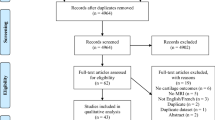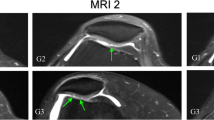Abstract
Objective
Running is among the most popular recreational activities; nonetheless, the acute post-race changes of cartilage or meniscus have rarely been determined. The current study aimed to review the acute changes in knee cartilage and meniscus among habituate runners following long-distance running detected by using quantitative magnetic resonance imaging (MRI).
Materials and methods
Systematic literature search was performed on those dominate clinical databases which including MEDLINE, Cochrane, Embase, ScienceDirect, and Web of Science. Included studies should be conducted on healthy marathon runners, and the participants should be examined before and after running by using MRI. Intervention studies were excluded.
Results
A total number of 14 studies were finally included in this review which all examined the cartilage or meniscus by using MRI functional sequences. Among them, six studies quantitatively measured the changes regarding volume of the knee cartilage or/and meniscus. Five studies found that the volume would decrease initially after running. Ten studies reported T2 (T2*) would decrease after running and returned to the baseline in a short term, while T1ρ may remain increased in months. Five studies measured subareas for T2 (T2*) value, and found that the superficial and medial subarea changed more vastly than other regions after running.
Conclusion
Runners experience transient changes in the volume and signals of knee cartilage and meniscus after long-distance running. A liquid exchange and material interaction in cartilage and meniscus was observed after running. Superficial and medial areas of knee cartilage and meniscus might be more susceptible to mechanical loading.

Similar content being viewed by others
Data availability
Not applicable.
References
Schueller-Weidekamm C, Schueller G, Uffmann M, Bader T. Incidence of chronic knee lesions in long-distance runners based on training level: findings at MRI. Eur J Radiol. 2006;58(2):286–93.
Subburaj K, Kumar D, Souza RB, Alizai H, Li X, Link TM, Majumdar S. The acute effect of running on knee articular cartilage and meniscus magnetic resonance relaxation times in young healthy adults. Am J Sports Med. 2012;40(9):2134–41.
Souza RB, Stehling C, Wyman BT, Hellio Le Graverand MP, Li X, Link TM, Majumdar S. The effects of acute loading on T1rho and T2 relaxation times of tibiofemoral articular cartilage. Osteoarthritis Cartilage. 2010;18(12):1557–63.
Chen M, Qiu L, Shen S, Wang F, Zhang J, Zhang C, Liu S. The influences of walking, running and stair activity on knee articular cartilage: quantitative MRI using T1 rho and T2 map**. PLoS One. 2017;12(11): e0187008.
Horisberger M, Fortuna R, Valderrabano V, Herzog W. Long-term repetitive mechanical loading of the knee joint by in vivo muscle stimulation accelerates cartilage degeneration and increases chondrocyte death in a rabbit model. Clin Biomech. 2013;28(5):536–43.
Smith RL, Carter DR, Schurman DJ. Pressure and shear differentially alter human articular chondrocyte metabolism: a review. Clin Orthop Relat Res. 2004;(427 Suppl):S89–95.
Fang T, Zhou X, ** M, Nie J, Li X. Molecular mechanisms of mechanical load-induced osteoarthritis. Int Orthop. 2021;45(5):1125–36.
Alentorn-Geli E, Samuelsson K, Musahl V, Green CL, Bhandari M, Karlsson J. The association of recreational and competitive running with hip and knee osteoarthritis: a systematic review and meta-analysis. J Orthop Sports Phys Ther. 2017;47(6):373–90.
Subburaj K, Kumar D, Souza RB, et al. The acute effect of running on knee articular cartilage and meniscus magnetic resonance relaxation times in young healthy adults. Am J Sports Med. 2012;40(9):2134–41.
Liu B, Lad NK, Collins AT, et al. In vivo tibial cartilage strains in regions of cartilage-to-cartilage contact and cartilage-to-meniscus contact in response to walking. Am J Sports Med. 2017;45(12):2817–23.
McCann L, Ingham E, ** Z, Fisher J. Influence of the meniscus on friction and degradation of cartilage in the natural knee joint. Osteoarthritis Cartilage. 2009;17(8):995–1000.
Chen S, Fu P, Wu H, Pei M. Meniscus, articular cartilage and nucleus pulposus: a comparative review of cartilage-like tissues in anatomy, development and function. Cell Tissue Res. 2017;370(1):53–70.
Kleemann RU, Krocker D, Cedraro A, Tuischer J, Duda GN. Altered cartilage mechanics and histology in knee osteoarthritis: relation to clinical assessment (ICRS Grade). Osteoarthritis Cartilage. 2005;13(11):958–63.
Liess C, Lüsse S, Karger N, Heller M, Glüer CC. Detection of changes in cartilage water content using MRI T2-map** in vivo. Osteoarthritis Cartilage. 2002;10(12):907–13.
Sophia Fox AJ, Bedi A, Rodeo SA. The basic science of articular cartilage: structure, composition, and function. Sports Health. 2009;1(6):461–8.
Van Breuseghem I. Ultrastructural MR imaging techniques of the knee articular cartilage: problems for routine clinical application. Eur Radiol. 2004;14(2):184–92.
Tao H, Qiao Y, Hu Y, et al. Quantitative T2-map** and T2⁎-map** evaluation of changes in cartilage matrix after acute anterior cruciate ligament rupture and the correlation between the results of both methods. Biomed Res Int. 2018;2018:7985672.
Behzadi C, Welsch GH, Laqmani A, et al. The immediate effect of long-distance running on T2 and T2* relaxation times of articular cartilage of the knee in young healthy adults at 3.0 T MR imaging. Br J Radiol. 2016;89(1064):20151075.
Bolbos RI, Link TM, Ma CB, Majumdar S, Li X. T1rho relaxation time of the meniscus and its relationship with T1rho of adjacent cartilage in knees with acute ACL injuries at 3 T. Osteoarthritis Cartilage. 2009;17(1):12–8.
Rauscher I, Stahl R, Cheng J, et al. Meniscal measurements of T1rho and T2 at MR imaging in healthy subjects and patients with osteoarthritis. Radiology. 2008;249(2):591–600.
Wheaton AJ, Dodge GR, Elliott DM, Nicoll SB, Reddy R. Quantification of cartilage biomechanical and biochemical properties via T1rho magnetic resonance imaging. Magn Reson Med. 2005;54(5):1087–93.
Li X, Pai A, Blumenkrantz G, et al. Spatial distribution and relationship of T1rho and T2 relaxation times in knee cartilage with osteoarthritis. Magn Reson Med. 2009;61(6):1310–8.
Cumpston M, Li T, Page MJ, et al. Updated guidance for trusted systematic reviews: a new edition of the Cochrane Handbook for Systematic Reviews of Interventions. Cochrane Database Syst Rev. 2019;10:ED000142.
Moher D, Liberati A, Tetzlaff J, Altman DG; PRISMA Group. Preferred reporting items for systematic reviews and meta-analyses: the PRISMA statement. PLoS Med. 2009;6(7):e1000097.
Stang A. Critical evaluation of the Newcastle-Ottawa scale for the assessment of the quality of nonrandomized studies in meta-analyses. Eur J Epidemiol. 2010;25(9):603–5.
Zhang P, Yu B, Zhang R, et al. Longitudinal study of the morphological and T2* changes of knee cartilages of marathon runners using prototype software for automatic cartilage segmentation. Br J Radiol. 2021;94(1119):20200833.
Kessler MA, Glaser C, Tittel S, Reiser M, Imhoff AB. Recovery of the menisci and articular cartilage of runners after cessation of exercise: additional aspects of in vivo investigation based on 3-dimensional magnetic resonance imaging. Am J Sports Med. 2008;36(5):966–70.
Mosher TJ, Liu Y, Torok CM. Functional cartilage MRI T2 map**: evaluating the effect of age and training on knee cartilage response to running. Osteoarthritis Cartilage. 2010;18(3):358–64.
Kersting UG, Stubendorff JJ, Schmidt MC, Brüggemann GP. Changes in knee cartilage volume and serum COMP concentration after running exercise. Osteoarthritis Cartilage. 2005;13(10):925–34.
Willwacher S, Mählich D, Trudeau MB, et al. The habitual motion path theory: evidence from cartilage volume reductions in the knee joint after 75 minutes of running. Sci Rep. 2020;10(1):1363.
Kessler MA, Glaser C, Tittel S, Reiser M, Imhoff AB. Volume changes in the menisci and articular cartilage of runners: an in vivo investigation based on 3-D magnetic resonance imaging. Am J Sports Med. 2006;34(5):832–6.
Luke AC, Stehling C, Stahl R, et al. High-field magnetic resonance imaging assessment of articular cartilage before and after marathon running: does long-distance running lead to cartilage damage? Am J Sports Med. 2010;38(11):2273–80.
Stehling C, Luke A, Stahl R, et al. Meniscal T1rho and T2 measured with 3.0T MRI increases directly after running a marathon. Skeletal Radiol. 2011;40(6):725–35.
Crowder HA, Mazzoli V, Black MS, et al. Characterizing the transient response of knee cartilage to running: decreases in cartilage T2 of female recreational runners. J Orthop Res. 2021.
Cha JG, Lee JC, Kim HJ, et al. Comparison of MRI T2 relaxation changes of knee articular cartilage before and after running between young and old amateur athletes. Korean J Radiol. 2012;13(5):594–601.
Esculier JF, Jarrett M, Krowchuk NM, et al. Cartilage recovery in runners with and without knee osteoarthritis: a pilot study. Knee. 2019;26(5):1049–57.
Heckelman LN, Smith WAR, Riofrio AD, et al. Quantifying the biochemical state of knee cartilage in response to running using T1rho magnetic resonance imaging. Sci Rep. 2020;10(1):1870.
Wang Z, Ai S, Tian F, et al. Higher body mass index is associated with biochemical changes in knee articular cartilage after marathon running: a quantitative T2-relaxation MRI study. Orthop J Sports Med. 2020;8(8):2325967120943874.
Hesper T, Miese FR, Hosalkar HS, et al. Quantitative T2(*) assessment of knee joint cartilage after running a marathon. Eur J Radiol. 2015;84(2):284–9.
Boocock M, McNair P, Cicuttini F, Stuart A, Sinclair T. The short-term effects of running on the deformation of knee articular cartilage and its relationship to biomechanical loads at the knee. Osteoarthritis Cartilage. 2009;17(7):883–90.
Qiu L, Perez J, Emerson C, et al. Biochemical changes in knee articular cartilage of novice half-marathon runners. J Int Med Res. 2019;47(11):5671–9.
Nag D, Liney GP, Gillespie P, Sherman KP. Quantification of T(2) relaxation changes in articular cartilage with in situ mechanical loading of the knee. J Magn Reson Imaging. 2004;19(3):317–22.
Otterness IG, Eckstein F. Women have thinner cartilage and smaller joint surfaces than men after adjustment for body height and weight. Osteoarthritis Cartilage. 2007;15(6):666–72.
Funding
This study was funded by the Medical and Health Science & Technology Project of Zhejiang Province (grant number 2020KY711) and the Key Medical Disciplines of Hangzhou (grant number YDYX).
Author information
Authors and Affiliations
Corresponding author
Ethics declarations
Institutional review board statement
Not applicable.
Informed consent
Not applicable.
Conflict of interest
The authors declare no competing interests.
Additional information
Publisher's note
Springer Nature remains neutral with regard to jurisdictional claims in published maps and institutional affiliations.
Rights and permissions
About this article
Cite this article
Shu, D., Chen, F., Guo, W. et al. Acute changes in knee cartilage and meniscus following long-distance running in habituate runners: a systematic review on studies using quantitative magnetic resonance imaging. Skeletal Radiol 51, 1333–1345 (2022). https://doi.org/10.1007/s00256-021-03943-0
Received:
Revised:
Accepted:
Published:
Issue Date:
DOI: https://doi.org/10.1007/s00256-021-03943-0




